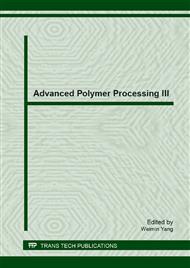p.460
p.466
p.472
p.478
p.483
p.490
p.496
p.501
p.506
Air Dynamics Characteristics Analysis of Air Splicer
Abstract:
Air splicing technology is the key technology to realize high speed, high quality and automatic winding in modern textile industry. However the current research of splicing mechanism is still in qualitative analysis, theoretical and experimental exploration stage. By modern computational mechanics method, with the air flow analysis results in different structures and shapes of splicer chamber, the air flow patterns under high pressure are determined; and the optimized structural characteristics of the splicing chamber are obtained in this paper. The results provide theoretical support on the innovative splicer chamber design, promote the development of the new air splicing technology, create important practical value, and provide the feasible means and methods in the air splicer theory research and optimization design.
Info:
Periodical:
Pages:
483-489
Citation:
Online since:
July 2013
Authors:
Keywords:
Price:
Сopyright:
© 2013 Trans Tech Publications Ltd. All Rights Reserved
Share:
Citation:


